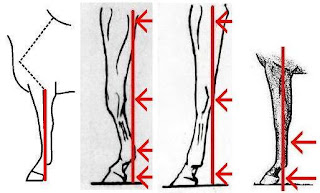To know the horse we must know how it is put together. A
great deal will be learned from the study of its skeleton.
Check this site out for more of the images above. the other side of the horse is its muscles. Also check out the YouTube videos. http://www.horsesinsideout.com/
- each limb with its 20 bones
Appendicular Skeleton
- the framework of 125 bones = vertebrae (the bones of the spine [back bones]) (cervical = neck, thoracic = chest, lumbar = low back) - ribs - pelvis (hips)
Function
- protect the internal organs = brain - heart - guts - central nervous system (CNS)- a pulley and suspension system (joints = wheels (levers), tendons and ligaments = ropes, and the muscles pull)
- framework and support (hold the horse all together) - the attachment for muscles, tendons [hold bones to muscles], and ligaments [hold bone to bone]
- movement because of the joints, muscles, tendon, and ligaments
- absorption of impact when the hooves hit the ground
- red blood cell production in the long bone marrow
- mineral storage
Types
- flat - broad surface for muscle attachment
- long - contain marrow, joint surface at both ends (epiphyses)
- short - (It is so good to have terms that are in just plain simple English)
- irregular - as in vertebrae (back bones)
- sesamoid - work with the tendons (embedded within a tendon)
'Dem Bones'
- 205+- (depends on who you are reading) + the skull with 34 bones (not including the auditory [ear] bones - 3 on each side)
Vertebrae: 7 cervical vertebrae (bones of the neck with the Atlas and Axis at the top), 18 Thoracic (rarely 19)(some Arabians 17), 6 Lumbar (some Arabians 5), 5 Sacral (fused as the Sacrum), 15 to 25 Coccygeal - average of 18 - some Arabians 17 - also called Caudal Vertebrae - I'll call these 'the tail', so much simpler.
Sternum: 1
Collar Bone (Clavicle): NONE
Forelimb: 1 Scapular, 1 Humerus, 1 Ulna (fused to the Radius), 1 Radius (fused to the Ulna), Carpal bones (7 in each knee)(actually not a knee but many will call it that), 1 Cannon (metacarpal) bone, 2 Splint Bones, 1 Long pastern (1st Phalanx), 1 Short pastern (2nd Phalanx), 1 Pedal Bone (3rd Phalanx), 2 Sesamoid bones, 1 Navicular bone
Hindlimb: 1 Sacrum (5 fused bones), 1 Pelvis (3 fused bones), 1 Femur, 1 Tibia, 1 Fibula, 7 Tarsus bones of the hock, 1 Cannon (metatarsal) bone, 2 Splint bones, 1 Long pastern (P1 or 1st Phalanx or First Phalange or Proximal Phalanx), 1 Short Pastern (P2 or 2nd Phalanx or Second Phalange or Middle Phalanx), 1 Pedal bone (P3 or 3rd Phalanx or Third Phalange or Distal Phalanx or Coffin Bone), 2 Sesamoid bones, 1 Navicular bone.
Skull: 34 to 37 bones.
Ribs: 36 ( some Arabians 34)
All bone joints have a cartilage cap (for wear and tear of the surfaces), a synovial capsule (a membrane that produces joint oil to lubricate the joint), and are strengthened by the ligaments.

























